Abstract
Human granulocytes (G) contain a vitamin B12-binding protein (B12BP). There is evidence that chronic myelogenous leukemia leukocytes (CMLL) may synthesize B12BP. Our prior studies suggested that intact, living intravascular G synthesize and release such protein into extracellular compartments in vivo.
In the present study, CMLL were incubated in Trisbuffered Hank's basal salt solution (pH 7.2) containing 0.1% human serum albumin to study release of B12BP into the medium. B12BP was released continuously and in increasing amounts over a 5 hr period at 37°C; this release was inhibited almost completely when the cells were incubated at 4°C and by about half as much in the presence of N-ethylmaleimide (1 mmole/liter). Cycloheximide (50 μg/ml) had no effect on the release of B12BP but significantly inhibited incorporation of leucine-3H into leukocyte protein. G incubated with 20 mg/ml of compound 48/80, an experimental histamine-releasing agent, had a 6-fold increase in release of B12BP over a 2 hr period.
Subcellular fractionation studies of human granulocytes demonstrate that most of the B12BP is associated with the granular (20,000 g) layer with an excellent correlation observed between its subcellular distribution and that of acid phosphatase.
These findings suggest that the release of B12BP from G is mediated by an active process and provide further evidence that granulocytes are secretory as well as phagocytic cells.
Full text
PDF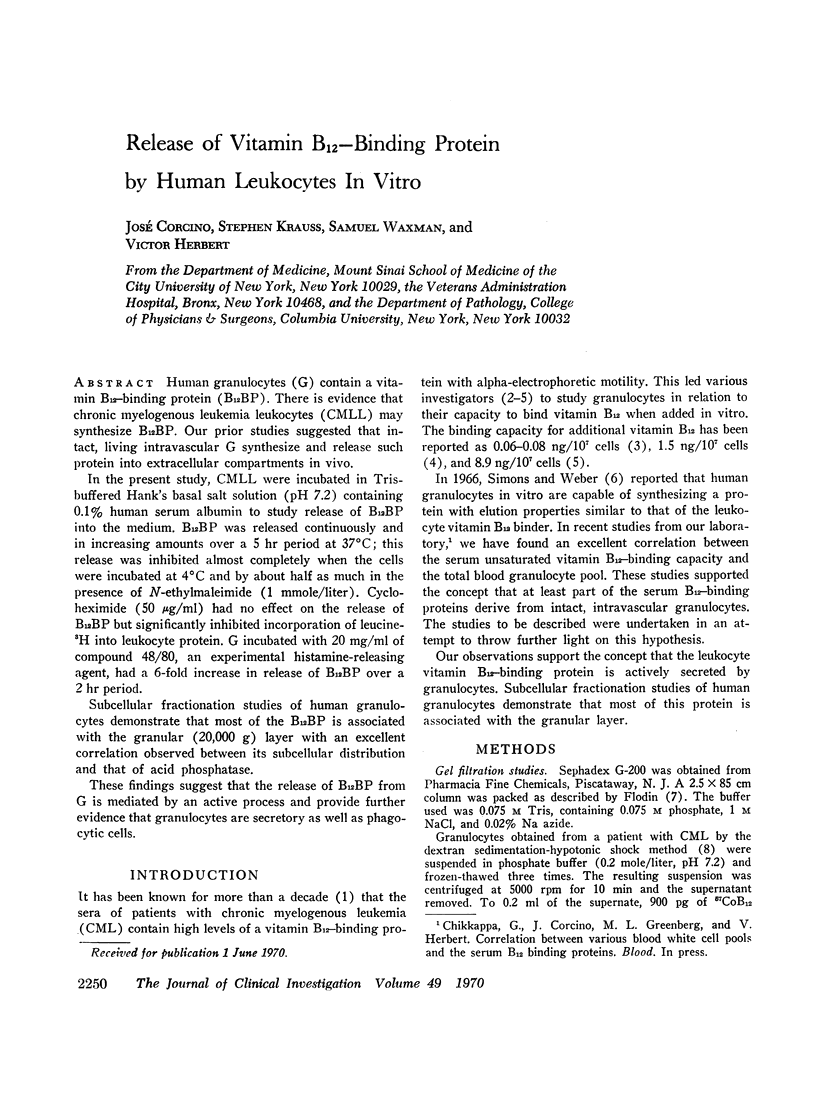
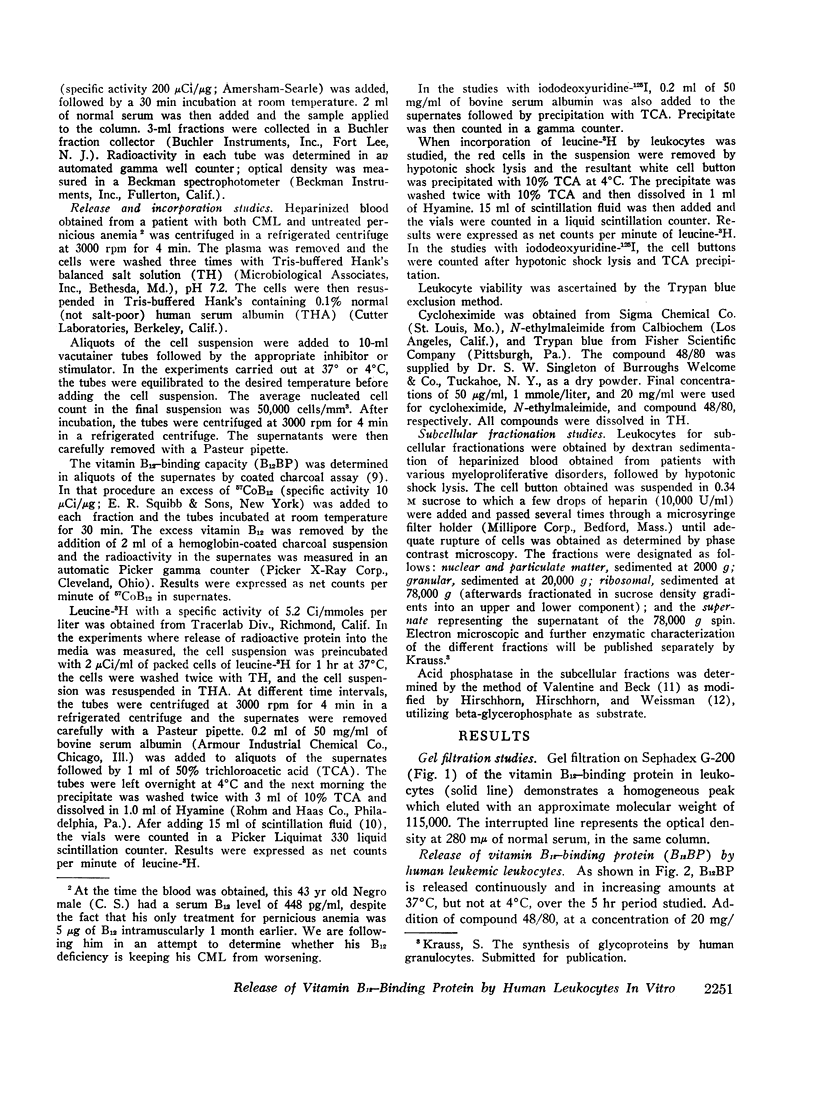
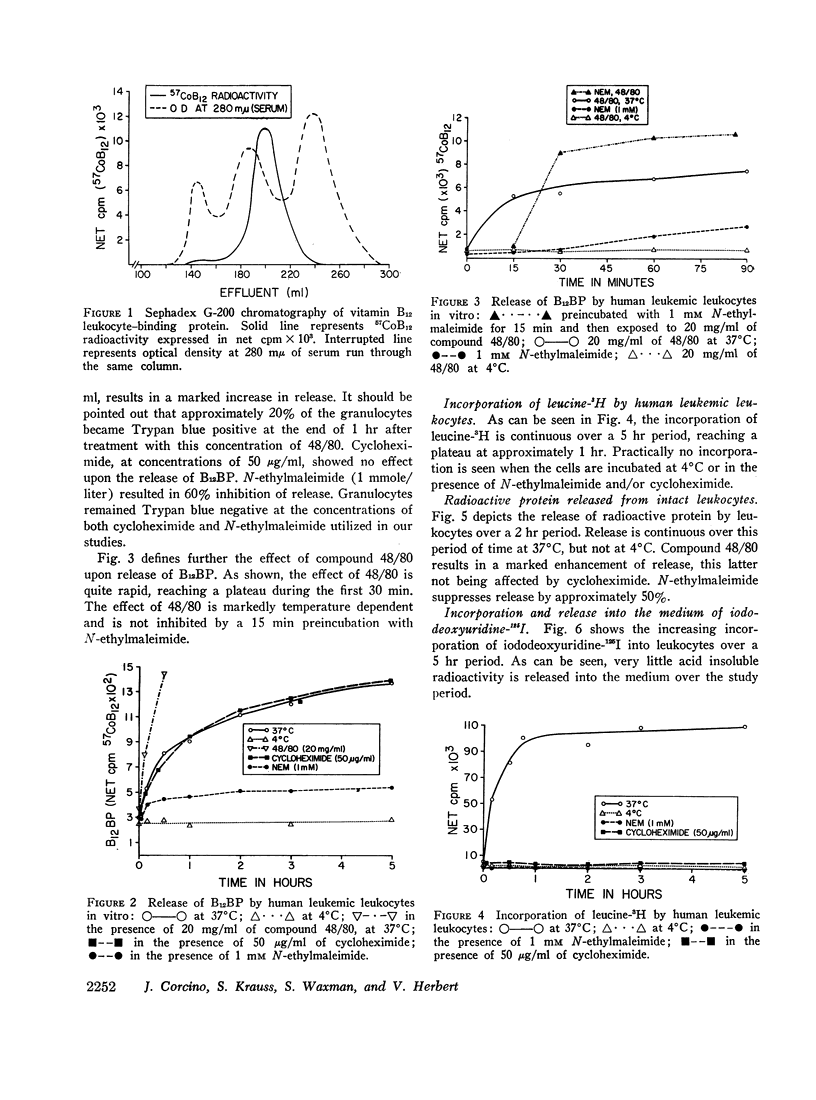
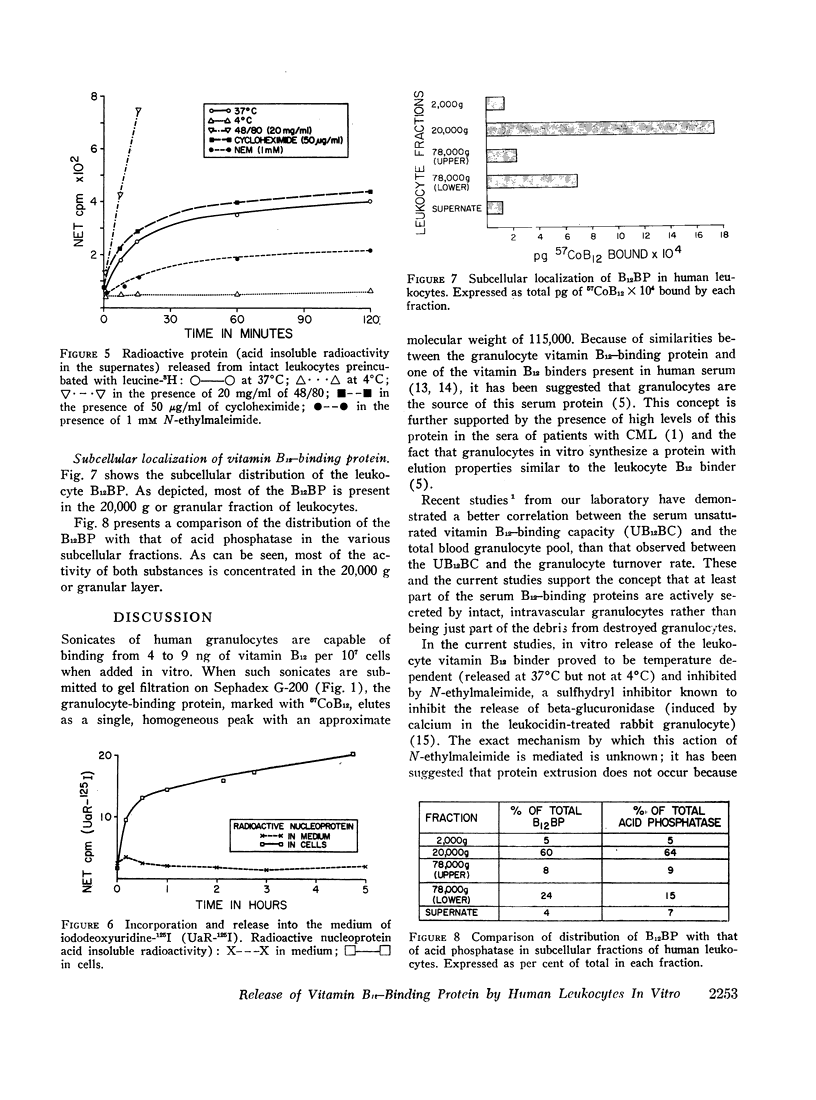
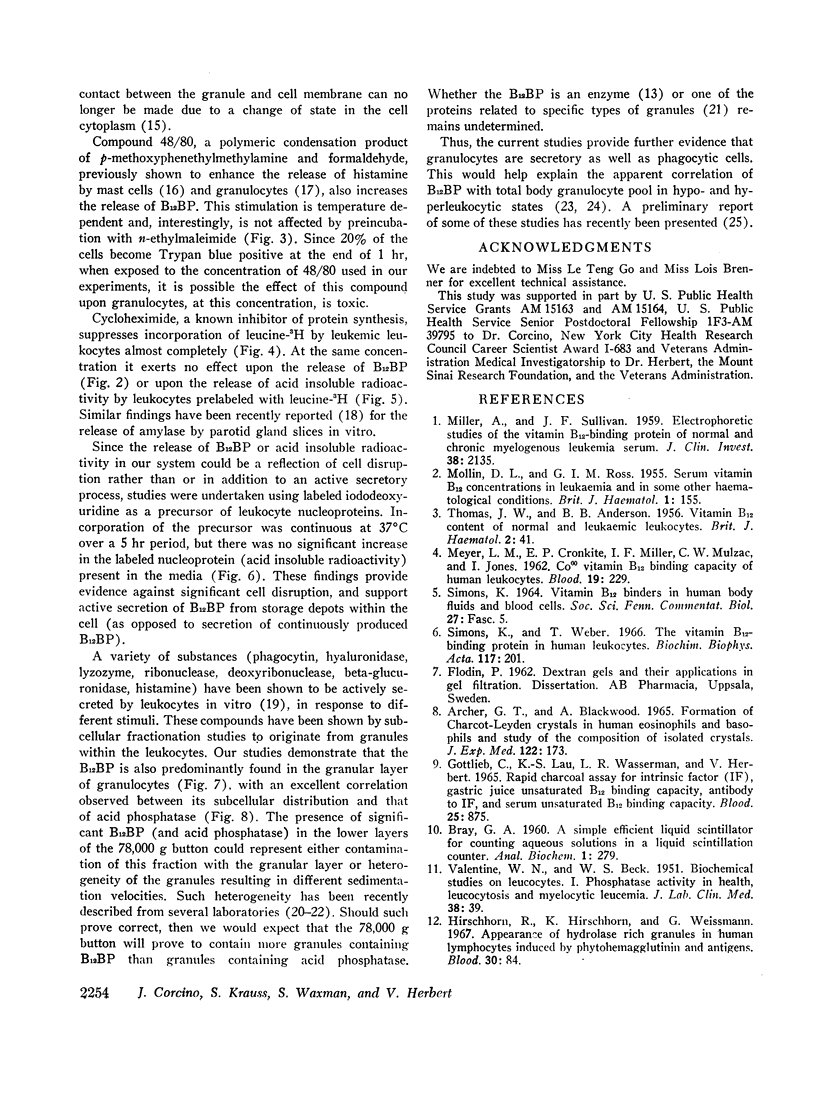
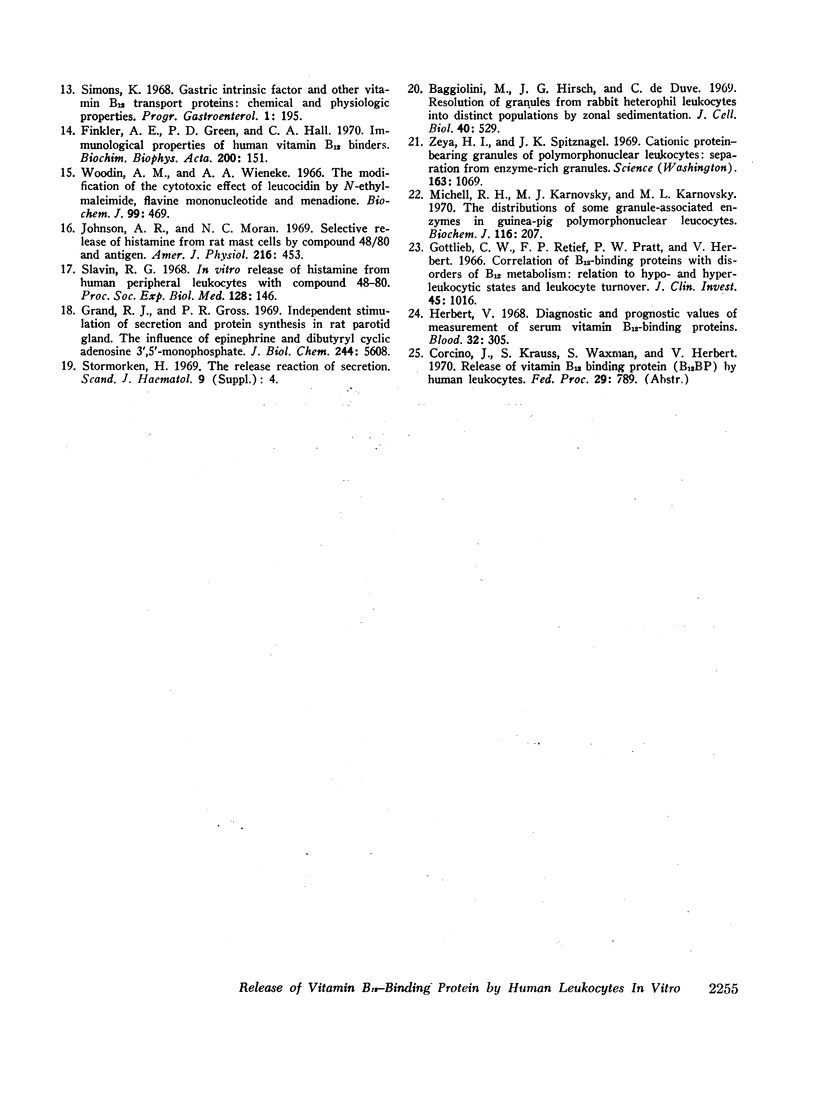
Images in this article
Selected References
These references are in PubMed. This may not be the complete list of references from this article.
- ARCHER G. T., BLACKWOOD A. FORMATION OF CHARCOT-LEYDEN CRYSTALS IN HUMAN EOSINOPHILS AND BASOPHILS AND STUDY OF THE COMPOSITION OF ISOLATED CRYSTALS. J Exp Med. 1965 Jul 1;122:173–180. doi: 10.1084/jem.122.1.173. [DOI] [PMC free article] [PubMed] [Google Scholar]
- Baggiolini M., Hirsch J. G., De Duve C. Resolution of granules from rabbit heterophil leukocytes into distinct populations by zonal sedimentation. J Cell Biol. 1969 Feb;40(2):529–541. doi: 10.1083/jcb.40.2.529. [DOI] [PMC free article] [PubMed] [Google Scholar]
- Finkler A. E., Green P. D., Hall C. A. Immunological properties of human vitamin B 12 binders. Biochim Biophys Acta. 1970 Jan 20;200(1):151–159. doi: 10.1016/0005-2795(70)90053-x. [DOI] [PubMed] [Google Scholar]
- GOTTLIEBLAU K. S., WASSERMAN L. R., HERBERT V. RAPID CHARCOAL ASSAY FOR INTRINSIC FACTOR (IF), GASTRIC JUICE UNSATURATED B12 BINDING CAPACITY, ANTIBODY TO IF, AND SERUM UNSATURATED B12 BINDING CAPACITY. Blood. 1965 Jun;25:875–884. [PubMed] [Google Scholar]
- Grand R. J., Gross P. R. Independent smulation of secretion and protein snthesis in rat parotid gland. The influence of epinephrine and dibutyryl cyclic adenosine 3',5'-monophosphate. J Biol Chem. 1969 Oct 25;244(20):5608–5615. [PubMed] [Google Scholar]
- Herbert V. Diagnostic and prognostic values of measurement of serum vitamin B12-binding proteins. Blood. 1968 Aug;32(2):305–312. [PubMed] [Google Scholar]
- Hirschhorn R., Hirschhorn K., Weissmann G. Appearance of hydrolase rich granules in human lymphocytes induced by phytohemagglutinin and antigens. Blood. 1967 Jul;30(1):84–102. [PubMed] [Google Scholar]
- Johnson A. R., Moran N. C. Selective release of histamine from rat mast cells by compound 48-80 and anitgen. Am J Physiol. 1969 Mar;216(3):453–459. doi: 10.1152/ajplegacy.1969.216.3.453. [DOI] [PubMed] [Google Scholar]
- MEYER L. M., CRONKITE E. P., MILLER I. F., MULZAC C. W., JONES I. Co60 vitamin B12 binding capacity of human leukocytes. Blood. 1962 Feb;19:229–235. [PubMed] [Google Scholar]
- MILLER A., SULLIVAN J. F. Electrophoretic studies of the vitamin B12-binding protein of normal and chronic myelogenous leukemia serum. J Clin Invest. 1959 Dec;38:2135–2143. doi: 10.1172/JCI103992. [DOI] [PMC free article] [PubMed] [Google Scholar]
- MOLLIN D. L., ROSS G. I. Serum vitamin B12 concentrations in leukaemia and in some other haematological conditions. Br J Haematol. 1955 Apr;1(2):155–172. doi: 10.1111/j.1365-2141.1955.tb05497.x. [DOI] [PubMed] [Google Scholar]
- Michell R. H., Karnovsky M. J., Karnovsky M. L. The distributions of some granule-associated enzymes in guinea-pig polymorphonuclear leucocytes. Biochem J. 1970 Jan;116(2):207–216. doi: 10.1042/bj1160207. [DOI] [PMC free article] [PubMed] [Google Scholar]
- Simons K., Weber T. The vitamin B12-binding protein in human leukocytes. Biochim Biophys Acta. 1966 Mar 28;117(1):201–208. doi: 10.1016/0304-4165(66)90167-x. [DOI] [PubMed] [Google Scholar]
- Slavin R. G. In vitro release of histamine from human peripheral leukocytes with compound 48/80. Proc Soc Exp Biol Med. 1968 May;128(1):146–149. doi: 10.3181/00379727-128-32965. [DOI] [PubMed] [Google Scholar]
- THOMAS J. W., ANDERSON B. B. Vitamin B12 content of normal and leukaemic leucocytes. Br J Haematol. 1956 Jan;2(1):41–43. doi: 10.1111/j.1365-2141.1956.tb06682.x. [DOI] [PubMed] [Google Scholar]
- VALENTINE W. N., BECK W. S. Biochemical studies on leucocytes. I. Phosphatase activity in health, leucocytosis, and myelocytic leucemia. J Lab Clin Med. 1951 Jul;38(1):39–55. [PubMed] [Google Scholar]
- Woodin A. M., Wienekeaa The modification of the cytotoxic effect of leucocidin by N-ethylmaleimide, flavine mononucleotide and mendione. Biochem J. 1966 May;99(2):469–478. doi: 10.1042/bj0990469. [DOI] [PMC free article] [PubMed] [Google Scholar]
- Zeya H. I., Spitznagel J. K. Cationic protein-bearing granules of polymorphonuclear leukocytes: separation from enzyme-rich granules. Science. 1969 Mar 7;163(3871):1069–1071. doi: 10.1126/science.163.3871.1069. [DOI] [PubMed] [Google Scholar]



